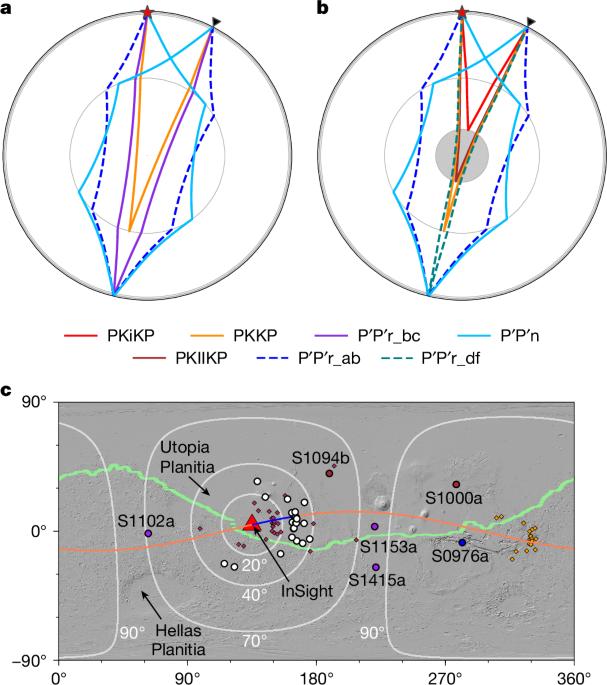Seismic detection of a 600-km solid inner core in Mars
IF 48.5
1区 综合性期刊
Q1 MULTIDISCIPLINARY SCIENCES
引用次数: 0
Abstract
For rocky planets, the presence of a solid inner core has notable implications on the composition and thermal evolution of the core and on the magnetic history of the planet1–3. On Mars, geophysical observations have confirmed that the core is at least partially liquid4–7, but it is unknown whether any part of the core is solid. Here we present an analysis of seismic data acquired by the InSight mission, demonstrating that Mars has a solid inner core. We identify two seismic phases, the deep core-transiting phase, PKKP, and the inner core boundary reflecting phase, PKiKP, indicative of the inner core. Our inversions constrain the radius of the Martian inner core to about 613 ± 67 km, with a compressional velocity jump of around 30% across the inner core boundary, supported by additional inner-core-related seismic phases. These properties imply a concentration of distinct light elements in the inner core, segregated from the outer core through core crystallization. This finding provides an anchor point for understanding the thermal and chemical state of Mars. Moreover, the relationship between inner core formation and the Martian magnetic field evolution could provide insights into dynamo generation across planetary bodies. An analysis of seismic data acquired by the InSight mission demonstrates that Mars has a 600-km solid inner core.

火星600公里固体内核的地震探测
对于岩石行星来说,固体内核的存在对内核的组成和热演化以及行星的磁历史具有重要意义1 - 3。在火星上,地球物理观测已经证实,地核至少部分是液态的,但是否有部分是固态的还不得而知。在这里,我们展示了对洞察号任务获得的地震数据的分析,证明火星有一个坚实的内核。我们确定了两个地震相,即深核过渡相PKKP和内核边界反射相PKiKP,它们指示了内核。我们的反演将火星内核的半径限制在约613±67公里,在内核边界上的压缩速度跳跃约为30%,并得到了额外的内核相关地震相位的支持。这些性质意味着不同的轻元素集中在内核中,通过内核结晶与外核分离。这一发现为了解火星的热化学状态提供了一个定位点。此外,内核形成与火星磁场演化之间的关系可以为跨行星体的发电机产生提供见解。对洞察号获得的地震数据的分析表明,火星有一个600公里长的固体内核。
本文章由计算机程序翻译,如有差异,请以英文原文为准。
求助全文
约1分钟内获得全文
求助全文
来源期刊

Nature
综合性期刊-综合性期刊
CiteScore
90.00
自引率
1.20%
发文量
3652
审稿时长
3 months
期刊介绍:
Nature is a prestigious international journal that publishes peer-reviewed research in various scientific and technological fields. The selection of articles is based on criteria such as originality, importance, interdisciplinary relevance, timeliness, accessibility, elegance, and surprising conclusions. In addition to showcasing significant scientific advances, Nature delivers rapid, authoritative, insightful news, and interpretation of current and upcoming trends impacting science, scientists, and the broader public. The journal serves a dual purpose: firstly, to promptly share noteworthy scientific advances and foster discussions among scientists, and secondly, to ensure the swift dissemination of scientific results globally, emphasizing their significance for knowledge, culture, and daily life.
 求助内容:
求助内容: 应助结果提醒方式:
应助结果提醒方式:


